Pre-operational checklists are not “new”, “sexy” or exciting. What they are is the leading foundation of a safe, highly efficient, reliable and cost-effective mining operation!
In the cockpit?
The activity that occurs before takeoff is meant to insure that all the steps necessary are accomplished to ensure a safe flight not only for all personnel but also the equipment.
It’s not that the pilots haven’t done it a zillion times before. It is because they have and they also know that one missed step could lead to serious implications.
In the 2011 seminal work on checklists, The Checklist Manifesto: How to Get Things Right by Atul Gawande, the following observation by the author, even though he is a surgeon, could have be extracted directly from the mining industry.
“We don’t like checklists. They can be painstaking. They’re not much fun. But I don’t think the issue here is mere laziness. There’s something deeper, more visceral going on when people walk away not only from saving lives but from making money.
It somehow feels beneath us to use a checklist, an embarrassment.
It runs counter to deeply held beliefs about how the truly great among us—those we aspire to be—handle situations of high stakes and complexity.
The truly great are daring. They improvise. They do not have protocols and checklists. Maybe our idea of heroism needs updating.”
For those of you with any exposure to mining, or heavy industry for that matter, you will be able to easily relate to Mr. Gawande’s previous statement.
Pre-operational checklists: Ignored
Pre-operational checklists tended/tend to be “pencil-whipped”, ignored, or sloppily done, with of course the rare exception that is actually completed accurately and with useful notes. Why?
There are two, and probably many more, fundamental reasons.
The first one is historically, the equipment was quite basic and fundamental and didn’t require extensive pre-operation inspection/tests.
Basically it was “kick the tires and light the fires”.
Secondly, which was mentioned, human ego got in the way of sound judgment.
Without a clear understanding of the value of doing a pre-operational checklist, operators subjugated the task to a menial importance, when the complete opposite was the reality.
With history in mind, in many respects, mining has followed the similar path as aircraft, albeit slower. Instead of a B-17 we are concerned about a Jumbo Bolter, Remote operated Scoop, Scissor bolter etc. Again, Mr. Gawande describes the mining industry at its current stage. (substitute mining for aeronautics)
“Instead, they came up with an ingeniously simple approach: they created a pilot’s checklist. Its mere existence indicated how far aeronautics had advanced. In the early years of flight, getting an aircraft into the air might have been nerve-racking but it was hardly complex.
Using a checklist for takeoff would no more have occurred to a pilot than to a driver backing a car out of the garage. But flying this new plane was too complicated to be left to the memory of any one person, however expert.
The test pilots made their list simple, brief, and to the point— short enough to fit on an index card, with step-by-step checks for takeoff, flight, landing, and taxiing. It had the kind of stuff that all pilots know to do.
They check that the brakes are released, that the instruments are set, that the door and windows are closed, that the elevator controls are unlocked—dumb stuff. You wouldn’t think it would make that much difference. But with the checklist in hand, the pilots went on to fly the Model 299 a total of 1.8 million miles without one accident.
The army ultimately ordered almost thirteen thousand of the aircraft, which it dubbed the B-17. And, because flying the behemoth was now possible, the army gained a decisive air advantage in the Second World War, enabling its devastating bombing”
A similar scenario is rapidly unfolding in the world of mining and especially mobile equipment.
The rate of technological advancement is rapidly outstripping the capacity of operations and maintenance to keep pace.
The traditional generic five-minute walk-around, pencil whipped, checklist pre-op of a piece of equipment is no longer valid and, to be honest, likely never was.
Below is a classic generic pre-op checklist that probably came into existence in the 1950’s and is still used frequently in North America.
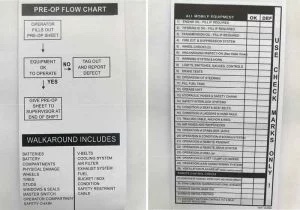
It would be normal to say “Unfortunately, the equipment is becoming so complex ….”
But that is not the case.
Instead, “fortunately” mining equipment is becoming so complex today that these traditional checklists are truly obsolete; however they are still being used.
Importantly, please note that this pre-operational checklist is typically turned in at the END of shift. In modern underground mining operations, most shifts are 12 hours and even a small equipment fault that is uncorrected can develop into a major breakdown over a span of a single shift.
However, all is not lost in the world of mining. New leadership is entering the industry and “daring” to rock the pillars of a slow to change culture.
One of those mines is Goldcorp’s new underground gold mine in Chapleau, Ontario, the Borden Mine. It is “disrupting mining” in a myriad of ways.
As Canada’s first totally electric underground mine, it is on the vanguard of both technology and management operating systems (MOS) for the mining industry.
The electric mobile mining equipment, in many cases, is just out of the prototype phase and represents a quantum technological leap from traditional diesel powered manual operated equipment.
It is not just the mobile mining equipment that has advanced. The advent of Industrial Internet of Things (IIoT) is now facilitating an enhanced underground asset health and maintenance management revolution.
The Borden underground mine, like others, is now completely connected to the surface via high speed Wi-Fi to the “cloud.”
Luc Poulin, the maintenance manager at Borden, astutely recognized the opportunity and his vision is to completely automate and convert operator pre-op inspections from generic paper-based pencil whipping exercises, with a time latency of over 12 hours, to real-time data-driven tablet-based pre-operational checklists.
Defects will be noted, prioritized and a SAP notification will be automatically generated for the supervisor/planner to be able to properly plan and schedule the work directly from underground.
“Here at GoldCorp’s Borden mine we are pushing the envelope of technology; we are ‘disrupting mining’.
We are Canada’s first completely electric underground mine and are extremely dependent on early detection of defects of our advanced underground mobile fleet, to properly plan, schedule and execute our maintenance to safely and reliably achieve our production goals.
Our first line of identification is from our operators during their pre-operational checklists. Together with IDCON, we are creating the next generation of digitally driven, real-time, operational, pre-operational checklists to drive reliability”
Luc Poulin, Maintenance Manager, GoldCorp Borden Mine
Stepping back to basic reliability, the P-F Curve clearly illustrates the value of early fault detection. Early detection allows for proactive monitoring, proper planning and scheduling, and ultimately effective and cost-effective maintenance which maximizes uptime.
The new tablet-based “Borden” underground, pre-operational checks harness not only the value of data driven inspections but also the real time capability of the internet, which not too long ago was not possible underground.
With the increasingly complex equipment, real time monitoring of assets and assessing the operator inspections/machine generated data is paramount to early detection of problems for corrective maintenance prior to catastrophic failures.
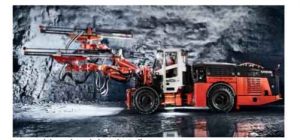
DD422E (Electric) Sandvik Jumbo Drill
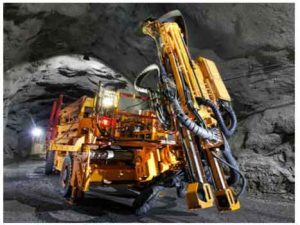
MacLean Omnia 975 Electric Scissor Bolter
Together with IDCON, inc., the Goldcorp Borden Mine reliability journey commenced in early 2018.
Recognizing that in order to capitalize on the opportunity, not only must pre-operational checklists become data-driven, operators also need to be extensively trained to understand what a pre-operational check is and actually why they are doing it.
Recognizing that reliability is a shared responsibility between maintenance and operations, the approach undertaken included creating an operator reference guide called “Pre-operational Condition Monitoring Standards” (CMS). This is a concise operational reference document that doesn’t supersede OEM manuals, but compliments them.
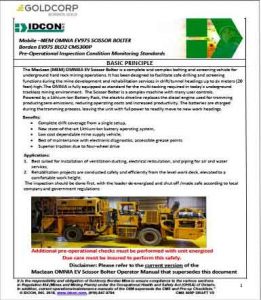
OMNIA EV975 Condition Monitoring Standard (CMS)
The Condition Monitoring Standard is then converted to the new data driven pre-operational checklists that capitalizes on the concept of Operation’s led reliability.
The following are page excerpts from a new Borden data-driven pre-operational checklist.
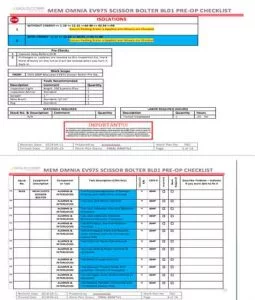
OMNIA EV975 Condition Monitoring Standard (CMS)
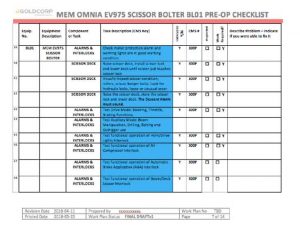
OMNIA EV975 Condition Monitoring Standard (CMS)
Excerpts from of “new” Borden expanded Equipment Pre-operational Checklist
In an industry that not too long ago was unfairly labeled as, “Dark, Dirty and Dangerous” and where Maintenance and Operations were “opposing” forces, the leadership of GoldCorp , Borden Mine has recognized that Safe Reliable Operations is actually a powerful shared vision for excellence for the entire organization.
The high tech revolution has taken it by storm and not only will it enable dramatically improved reliabilities and cost efficiencies but the collateral benefit is a safe operation.
This all begins with leadership and the daily commitment to a thorough and accurately completed pre-operations inspection.
Pre-operational checklists are not “new”, “sexy” or exciting. What they are is the leading foundation of a safe, highly efficient, reliable and cost effective mining operation!




